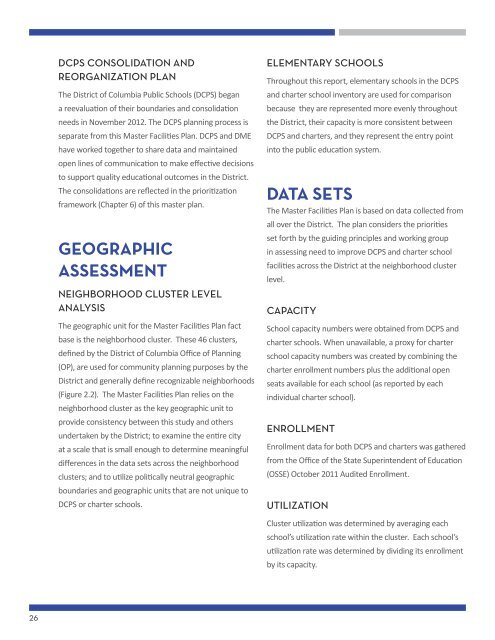DISTRICT COLUMBIA
DISTRICT COLUMBIA
DISTRICT COLUMBIA
Create successful ePaper yourself
Turn your PDF publications into a flip-book with our unique Google optimized e-Paper software.
26<br />
DCPS CONSOLIDATION AND<br />
REORGANIZATION PLAN<br />
The District of Columbia Public Schools (DCPS) began<br />
a reevaluation of their boundaries and consolidation<br />
needs in November 2012. The DCPS planning process is<br />
separate from this Master Facilities Plan. DCPS and DME<br />
have worked together to share data and maintained<br />
open lines of communication to make effective decisions<br />
to support quality educational outcomes in the District.<br />
The consolidations are reflected in the prioritization<br />
framework (Chapter 6) of this master plan.<br />
GEOGRAPHIC<br />
ASSESSMENT<br />
NEIGHBORHOOD CLUSTER LEVEL<br />
ANALYSIS<br />
The geographic unit for the Master Facilities Plan fact<br />
base is the neighborhood cluster. These 46 clusters,<br />
defined by the District of Columbia Office of Planning<br />
(OP), are used for community planning purposes by the<br />
District and generally define recognizable neighborhoods<br />
(Figure 2.2). The Master Facilities Plan relies on the<br />
neighborhood cluster as the key geographic unit to<br />
provide consistency between this study and others<br />
undertaken by the District; to examine the entire city<br />
at a scale that is small enough to determine meaningful<br />
differences in the data sets across the neighborhood<br />
clusters; and to utilize politically neutral geographic<br />
boundaries and geographic units that are not unique to<br />
DCPS or charter schools.<br />
ELEMENTARY SCHOOLS<br />
Throughout this report, elementary schools in the DCPS<br />
and charter school inventory are used for comparison<br />
because they are represented more evenly throughout<br />
the District, their capacity is more consistent between<br />
DCPS and charters, and they represent the entry point<br />
into the public education system.<br />
DATA SETS<br />
The Master Facilities Plan is based on data collected from<br />
all over the District. The plan considers the priorities<br />
set forth by the guiding principles and working group<br />
in assessing need to improve DCPS and charter school<br />
facilities across the District at the neighborhood cluster<br />
level.<br />
CAPACITY<br />
School capacity numbers were obtained from DCPS and<br />
charter schools. When unavailable, a proxy for charter<br />
school capacity numbers was created by combining the<br />
charter enrollment numbers plus the additional open<br />
seats available for each school (as reported by each<br />
individual charter school).<br />
ENROLLMENT<br />
Enrollment data for both DCPS and charters was gathered<br />
from the Office of the State Superintendent of Education<br />
(OSSE) October 2011 Audited Enrollment.<br />
UTILIZATION<br />
Cluster utilization was determined by averaging each<br />
school’s utilization rate within the cluster. Each school’s<br />
utilization rate was determined by dividing its enrollment<br />
by its capacity.


